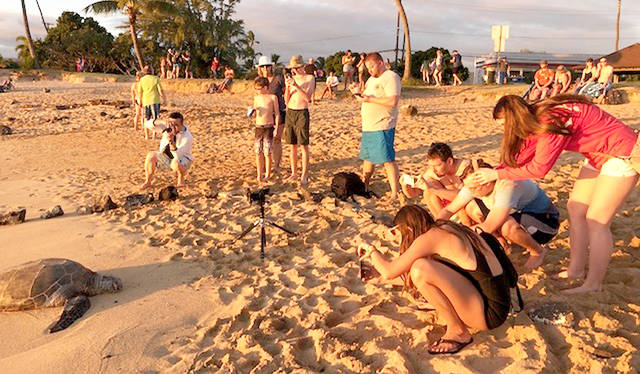POIPU — As 2019 broke over Kauai, visitor Dawn Reinfeld was ecstatic to see a threatened green sea turtle lounging on the beach near the lifeguard stand in Poipu.
Sitting about 30 feet from the animal, Reinfeld heard the lifeguards check out at the end of the day, reminding people to stay at least 20 feet away from the turtle.
She was shocked when people didn’t listen.
“I watched in dismay and anger as people got very, very close, shoving their cameras close to its face,” Reinfeld said.
After some time, someone finally took action and drew a line in the sand around the turtle and Reinfeld joined in the effort to put a few rocks along the line, indicating a sort of no-entry zone around the turtle.
Most people were honoring the rocks, she said, until a man who called himself a wildlife photographer landed on scene.
“(He) came and set his camera up within a couple feet or so of the turtle’s face, and a young woman got just as close with her camera,” Reinfeld said. “Children asked them to move and give the turtle space and they refused.”
Reinfeld said she confronted the wildlife photographer, who had left his camera to get time-lapse photos.
“He was arrogant and completely uncaring about the turtle,” Reinfeld said. “I took a couple of photos.”
Seeing endangered species up close and personal is one of Hawaii’s amazing benefits, but animals like Hawaiian monk seals, humpback whales and the threatened green sea turtles need to be approached cautiously.
Not only are there federal laws governing interaction with those species listed, including the Marine Mammal Protection Act and the Endangered Species Act, but irresponsible interactions can lead to harm of the animals.
Claire Simeone is hospital director at Ke Kai Ola, The Marine Mammal Center on the Big Island that specializes in the treatment and rehabilitation of Hawaiian monk seals.
“When we are thinking about responsible ways to view wildlife, we follow these rules and laws to keep both people and animals safe,” Simeone said. “These are wild animals, and they have the potential to hurt us as much as we have the potential to harm them.”
Interactions with Hawaiian monk seals and green sea turtles are the most common on Kauai because the animals tend to haul out, or climb up on the beach to rest, in highly populated places like Poipu Beach Park.
Hawaiian monk seals are among the most critically endangered species in the world, with only about 1,200 left.
Most of them live in the Northwestern Hawaiian Islands, but there is a growing population that’s giving birth on the main Hawaiian Islands.
Green sea turtles are listed as threatened under the ESA, and their numbers are increasing within the islands.
When it comes to legal interaction with endangered or threatened animals, there isn’t anything that states a specific distance you have to be from the animal, except for humpback whales. Federal law states no one may approach a humpback whale within 100 yards in Hawaii waters.
For Hawaiian monk seals and green sea turtles, the law says you can’t do anything that has the potential to disturb their natural behavioral patterns.
The Hawaii Department of Land and Natural Resources and the National Oceanic and Atmospheric Administration recommend staying 20 feet from turtles, 50 feet from monk seals, and 150 feet from monk seal mom/pup pairs.
If you encounter a humpback whale on or in the water and the whale approaches you, NOAA and DLNR recommend you stay put and wait for the whale to move away. Motorized vessels should put their engines in neutral.
Sometimes it’s hard to tell if you’re disturbing the animal or not, especially if it’s asleep on the beach. Simeone said animals hide pain and distress extremely well.
“What may seem to you like an animal that doesn’t seem to mind, may in fact be an animal that has changed its normal behavior — like resting or feeding — in response to your approach,” Simeone said.
She suggests: “If you feel that you might not make a large impact, think about the line of people that have come before you, and the line of people that will come after you. Those repeated interactions add up over time.”
•••
Jessica Else, environment reporter, can be reached at 245-0452 or jelse@thegardenisland.com.


